Philodendron Imperial Red: How To Grow This Tropical Houseplant
Are you a philodendron fan too? There’s nothing like these tropical plants, with their large showy leaves, to give a jungle vibe. Philodendron Imperial Red is no different. I’m sharing how to care for and successfully grow this beauty with large leathery leaves loaded with shine.
The Philodendron Imperial Red, sometimes called Red Philodendron, is a relatively new hybrid cultivar. Along with other philodendrons like Congo, Rojo Congo, and Prince of Orange, it was bred to be a houseplant. Growing tight to the center with a single base it’s a type of self-heading philodendron.
Mine is small and currently growing in a 6″ pot. The leaves will get larger and showier as the plant grows. The young leaves have a deep reddish tinge and the foliage matures to a semi-glossy dark green.
If you have a plant that looks like this but the foliage doesn’t have the red coloration and is more of bright medium green, it’s likely a Philodendron Imperial Green. The care is the same.
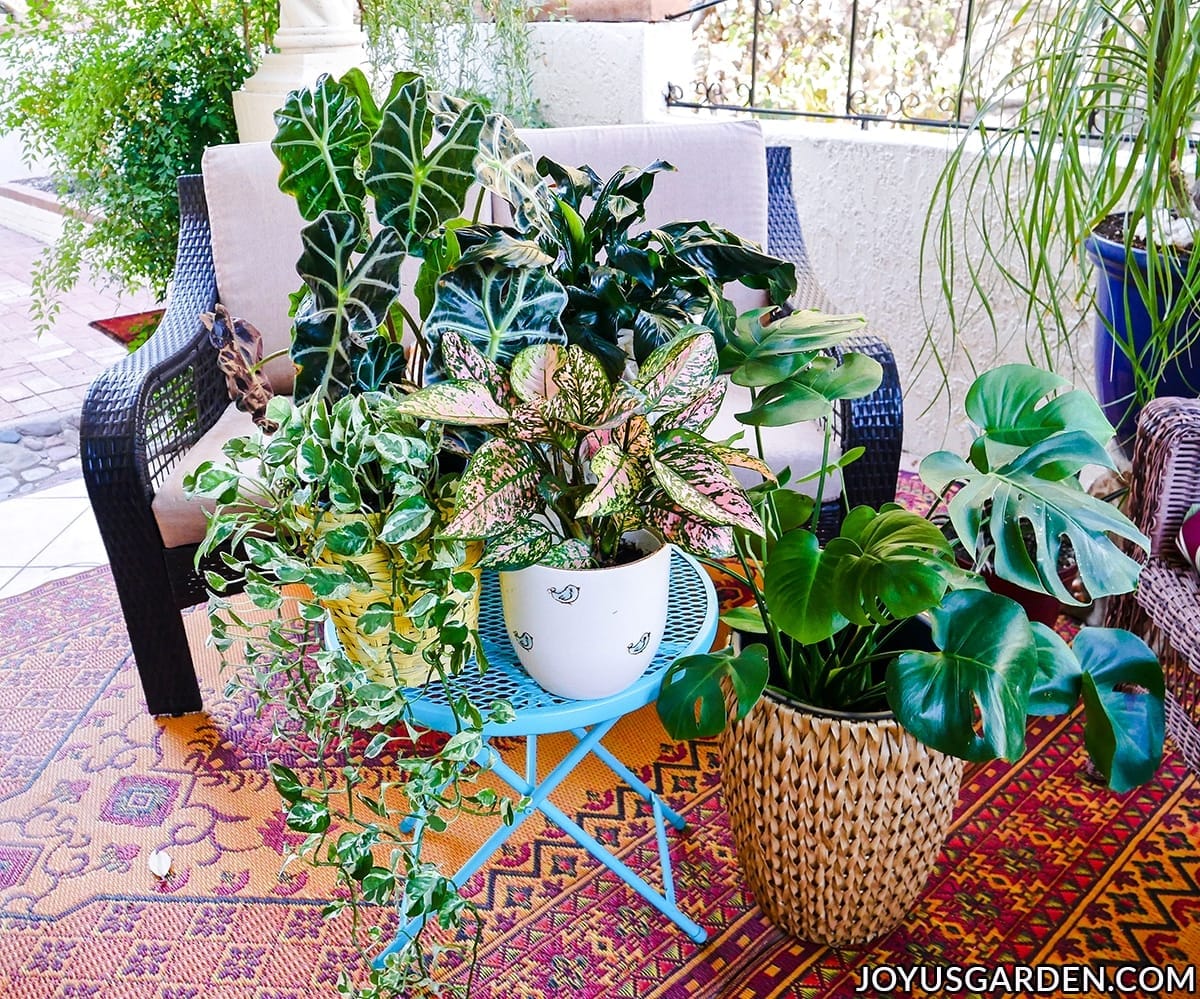
Here’s a fun fact for you plant geeks like me. This plant is an Araceae along with many other popular houseplants. Other family members include Anthuriums, dieffenbachias, Aglaonemas, Peace Lilies, African Mask Plant, Pothos, Arrowhead Plant, Monstera deliciosa, and the ZZ Plant.
This post may contain affiliate links, you can read our policies here.
Philodendron Imperial Red Traits
Size
It reaches 3′ x 3′, sometimes a bit bigger. The leaves and stems get bigger as it grows and the central trunk forms. Unlike some philodendrons, it has a more upright and neater rather than spreading growth habit.
Uses
Imperial Red philodendron is most commonly used as a tabletop plant. As it grows larger, it becomes a low, floor plant.
Growth Rate
Moderate. I find that this plant grows slower than some of the other houseplants in the Araceae family.
Why is this plant popular?
This decorative foliage plant has large glossy leaves that change color as they age.
Philodendron Imperial Red Video Guide
Philodendron Imperial Red Care
Exposure/Light
Like most houseplants, Philodendron Imperial Red prefers bright indirect sunlight. This would be considered a moderate or medium light exposure.
Mine sits on the long, narrow table alongside many other plants in my dining room. It’s about 8′ away from a bay window with east exposure.
Because I live in sunny Tucson (Arizona being the sunniest state in the US), this room receives bright light all day. It was at the far end of the table and I recently moved it to the end closest to the window so it could be closer to the source. I rotate it every few months so the back portion of the plant receives the light too.
This plant will tolerate higher light but be sure to keep it out of any direct hot sun to avoid sunburn. Conversely, if you have it in a too low light level, the leaves will eventually become stunted and the plant won’t grow too much if at all.
You may have to move your Imperial Red to a brighter spot in the darker winter months to get the light it needs.
Caring for indoor plants in winter can be different. Here are tips on Winter Houseplant Care.
Watering
I let this plant dry out almost 3/4 of the way before watering again. They don’t like to go completely dry but keeping the soil consistently wet will lead to root rot. Using a well-draining soil and having drainage holes in the bottom of the pot will definitely help with that by letting the excess water flow out.
In the warmer months, I water my Imperial Red every 7 days. In the winter, it’s every 10-14 days. Once a month, I take it to the kitchen sink and spray the foliage.
I always use room temperature water when watering my indoor plants.
I can’t tell give you exactly how often to water your plant because variables come into play. The watering schedule will vary for you depending on your home environment, the type of soil mix the plant is in, and the grow pot size.
If you’re new to indoor gardening, you’ll want to check out our Guide to Watering Indoor Plants to get a better understanding.
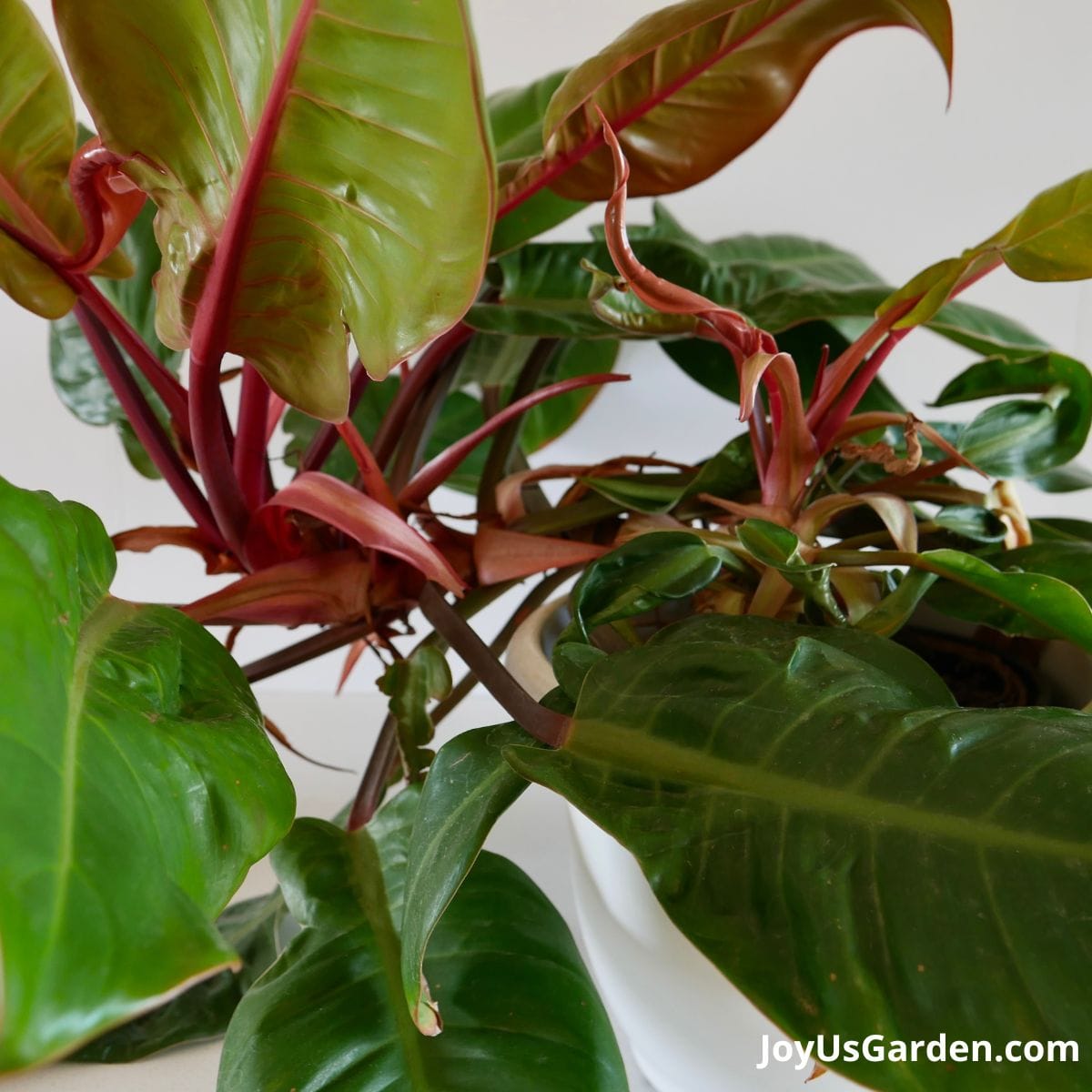
Temperature
If your home is comfortable for you, it’ll be so for your houseplants too. Just be sure to keep your plant away from any cold drafts as well as air conditioning or heating vents.
Imperial Reds like it on the warmer side in the growing months but don’t mind being cooler in the winter months.
Humidity
Because they’re cultivars and bred to be houseplants, they can tolerate the drier air in our homes.
Of course, they would prefer higher humidity levels. If the leaves are showing small brown tips, that’s a reaction to low humidity levels. This happens to many other houseplants too, like dracaenas and palms.
Here in hot dry Tucson, some of the leaves on mine have brown tips but the foliage is so dark, you have to look close to see them.
I have a large, deep kitchen sink with a faucet water filter. When I spray the foliage monthly, it not only cleans the foliage, but temporarily (very temporarily!) ups the ante on the humidity factor.
I have a humidity reader in my living room/dining room. I run tabletop humidifiers when the humidity is below 30%, which is a good deal of the time here in Arizona.
If you think yours look stressed due to lack of humidity, fill the saucer with pebbles and water. Put the plant on the pebbles but make sure the drain holes and/or the bottom of the pot aren’t submerged in water.
Imperial Red would appreciate a misting once or twice a week too.
I live in the Sonoran Desert. This is how I Increase The Humidity (or try to!) for my houseplants.
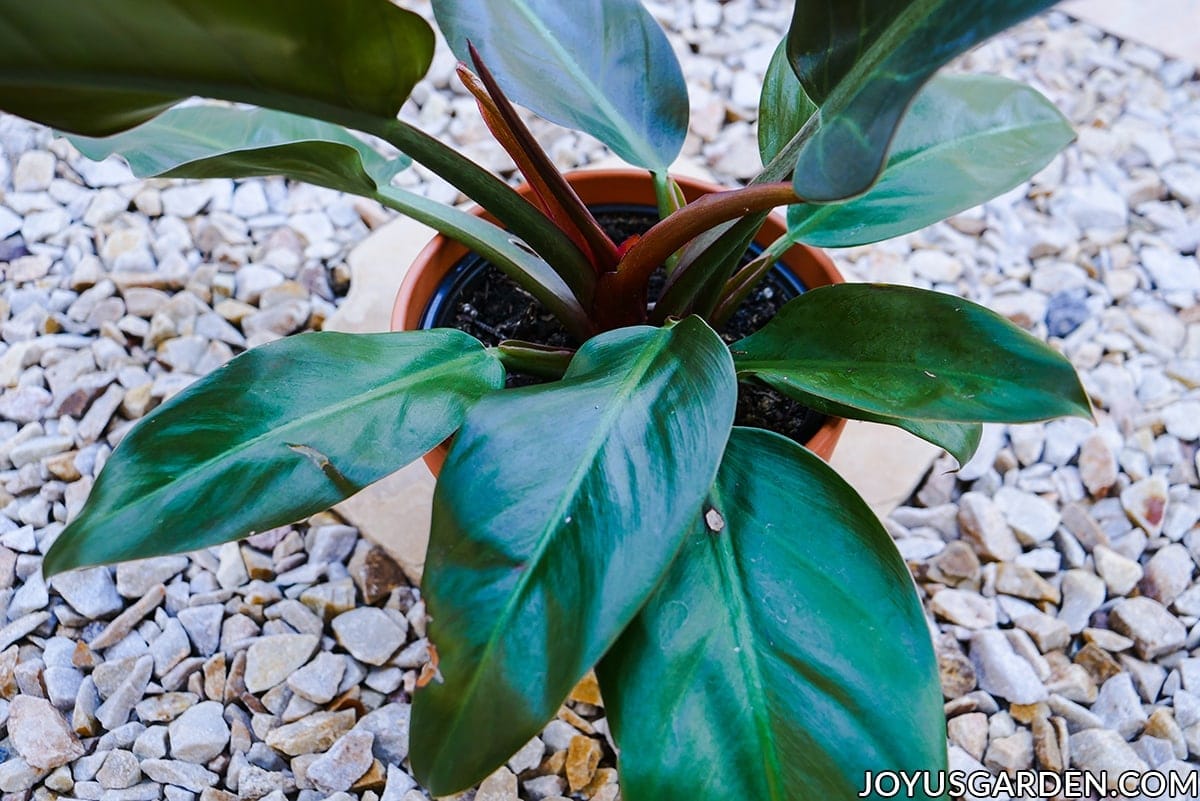
Fertilizer/Feeding
The best time of year to feed your indoor plants is spring through summer. Into early fall is fine if you’re in a climate with warmer winters like me.
I give most of my houseplants a light application of worm compost with a light layer of compost over that when repotting and as slow-release feeding every 2 or 3 years. Easy does it – 1/4 ” layer of each for a 6″ size houseplant. Read about my worm compost/compost feeding right here.
I give my Philodendron a watering with Eleanor’s VF-11 3 or 4 times during the warmer months. Online orders of this product are unavailable now because of the 2022 supply chain issue but keep checking. No word on when it’ll be back in.
I’ve subbed Grow Big for Eleanor’s and have been happy with that so far.
Alternately, I feed with Maxsea 3-4 times per year also. We have a long growing season here so my potted plants need and appreciate the nourishment.
Other options would be kelp/seaweed fertilizer and Joyful Dirt. Both are popular and get great reviews.
Feeding 2 or 3 times a year with a balanced fertilizer may be enough for your Imperial Red depending on your growing season.
Don’t overfertilize (either using too much a ratio or doing it too often or both) because many fertilizers are high in salts which can eventually lead to root burn.
Avoid fertilizing a houseplant that is stressed, ie. bone dry or soaking wet. I stop feeding my plants in late fall and resume in early spring.
Soil
A Philodendron Imperial Red plant loves and needs rich soil that contains organic matter and is well-draining. You don’t want the roots to stay too wet otherwise they’ll rot out.
Mine is currently planted in a “peaty” potting mix. When I repot, I’ll use 1/2 potting soil and 1/2 of DIY Succulent & Cactus Mix. The DIY mix contains coco chips and coco coir but I’ll toss in a bit extra of each. Coco coir is a more sustainable alternative to peat moss and has basically the same properties.
Use a potting soil that is formulated for indoor plants. I alternate between Happy Frog and Ocean Forest, and sometimes I combine them. Both have lots of good stuff in them and I use these potting mixes for my outdoor container plants too.
I’ll add in a handful of worm compost and compost for extra richness top it all with a 1/4″ layer of worm compost (for extra richness)
I have many plants (both indoors and outdoors) and do a lot of planting and repotting so I have a variety of materials on hand at all times. Plus, I have plenty of room in my garage to store all the bags and pails.
If you have limited space, listed below are a few alternative mixes suitable for Philodendron Imperial Red repotting consisting of only 2 materials.
Alternative mixes:
- 1/2 potting soil, 1/2 coco fiber or peat moss
- 1/2 potting soil, 1/2 orchid bark or coco chips
- 3/4 potting soil, 1/4 pumice or perlite
Repotting
Repotting/transplanting is best done in spring or summer; early fall is fine if you’re in a climate with warmer winters.
You’ll want to repot this plant only when needed. That may be every 4 years or every 6 years depending on how it’s growing. I’ve had mine for almost 4 years now and it’s still in the same pot as when I bought it.
The general rule with this plant in terms of pot size is to go up 1. Mine is in a 6″ grow pot now so I’ll go to an 8″ grow pot when repotting time rolls around.
Pruning
Not much is needed for this one. The main reason to prune yours would be to take off the occasional dead leaves or yellow leaves, usually at the base of the plant.
Just make sure your Pruners Are Clean and Sharp before you do any pruning.
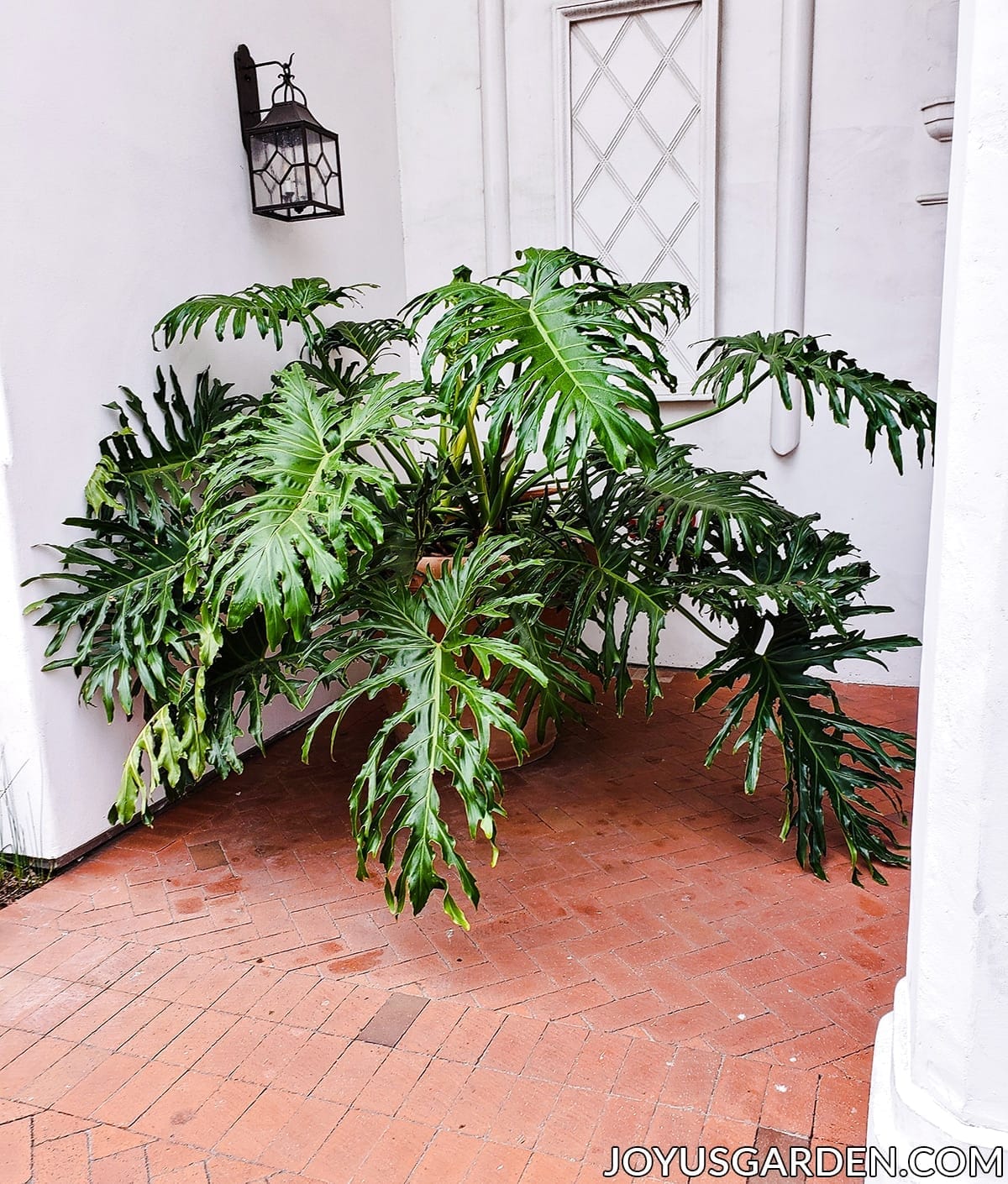
Propagation
This is 1 houseplant that I’ve never propagated. I’ve heard it can be done by stem cuttings or air layering. In case you’re not familiar with the latter, you can see how I Air Layered My Rubber Plant here.
Growers use a method called tissue culture to propagate this plant.
Pests
Mine has never gotten any.
They can be susceptible to Mealybugs, especially deep inside the new growth. These white, cotton-like pests like to hang out in the nodes and under the leaves. I simply blast them off (lightly!) in the kitchen sink with the spray and that does the trick.
Also, keep your eye out for Aphids and Spider Mites.
It’s best to take action as soon as you see any pest because they multiply like crazy. Pests can travel from houseplant to houseplant fast so make you get them under control as soon as you see them.
Pet Safety
Philodendron Imperial Red, like all plants mentioned above in the Araceae family, is considered to be toxic. I consult the ASPCA website for my info on this subject and see in what way the plant is toxic.
Some Of Our General Houseplant Guides For Your Reference: Guide To Watering Indoor Plants, Beginner’s Guide To Repotting Plants, How to Clean Houseplants, Winter Houseplant Care Guide, Plant Humidity: How I Increase Humidity For Houseplants, Buying Houseplants: 14 Tips For Indoor Gardening Newbies
A Few More Important Points
You can put your Imperial Red outdoors for the summer months. Just be sure to keep it out of the direct hot sun to avoid burn. If you live in a hot, dry desert like me, I’d recommend keeping it indoors year-round.
Before you bring it back indoors for the colder months, be sure to give it good spraying off (under the leaves too) to avoid bringing any unwanted pests indoors.
If the leaves of your Philodendron Imperial Red are turning brown, this could be due to a few reasons. Too much sun, a watering issue (most commonly overwatering), or fertilizer burn.
This plant has gorgeous foliage and this is what it’s grown for. Be sure to keep it cleaned off so it can looks its best. Here is some info on how and why I Clean My Houseplants, naturally of course!

Philodendron Imperial Red FAQs
Not, this isn’t a climbing philodendron like the Philodendron Brasil. This is a self-heading philodendron (meaning it grows off a single base) and the plant doesn’t get too big.
This is a small to medium-sized houseplant. It usually maxes out around 3′.
The water requirements are basically the same as for many other philodendrons. You don’t want it to go dry, nor do you want to keep the soil soggy. Check “Watering” towards the top for more details.
What is the best fertilizer for Philodendron?
A balanced all-purpose fertilizer formulated for houseplants is fine.
I had been using Eleanor’s VF-11 but it’s been unavailable for over a year now.
I’ve subbed Grow Big for Eleanor’s, which I use 3-4 times during the season, and have been happy with that so far.
Alternately, I feed with Maxsea 3-4 times per year also. We have a long growing season here so my potted plants need and appreciate the nourishment.
Other options would be this kelp/seaweed fertilizer, Joyful Dirt, or your favorite indoor plant food.
No, I wouldn’t say it’s rare. I bought mine in Northern San Diego County where there are many plant growers.
It can be hard to find at many nurseries and garden centers though. There are shops specializing in houseplants popping up so you might be able to find one there. Or, see if they’ll order 1 for you.
Here are the most important things to know about caring for an Imperial Red:
- Place it in bright natural light
- Don’t let it completely dry out but don’t keep it soggy
- It prefers a rich soil mix
Add this philodendron red beauty to your collection and you’ll be feeling the tropical vibes in no time!
Happy gardening,


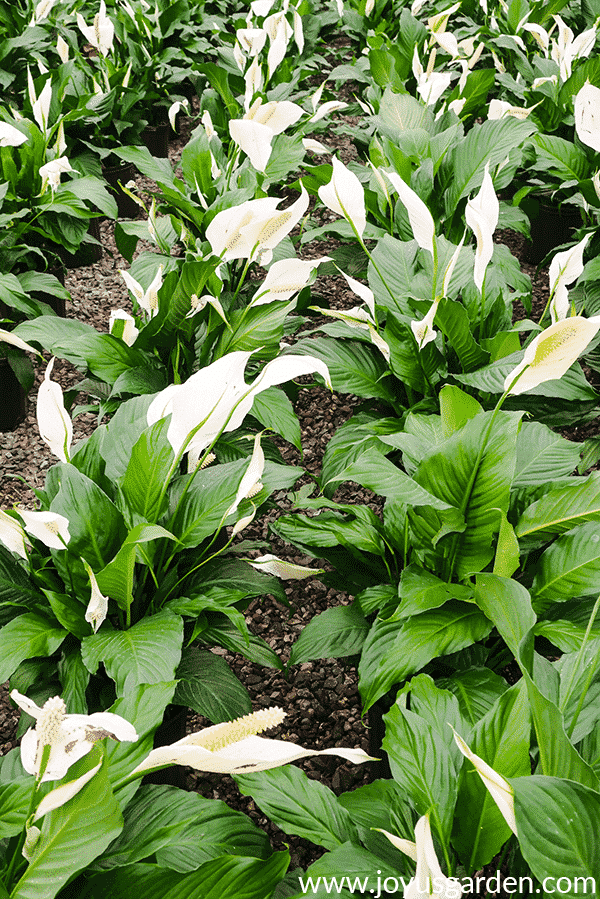

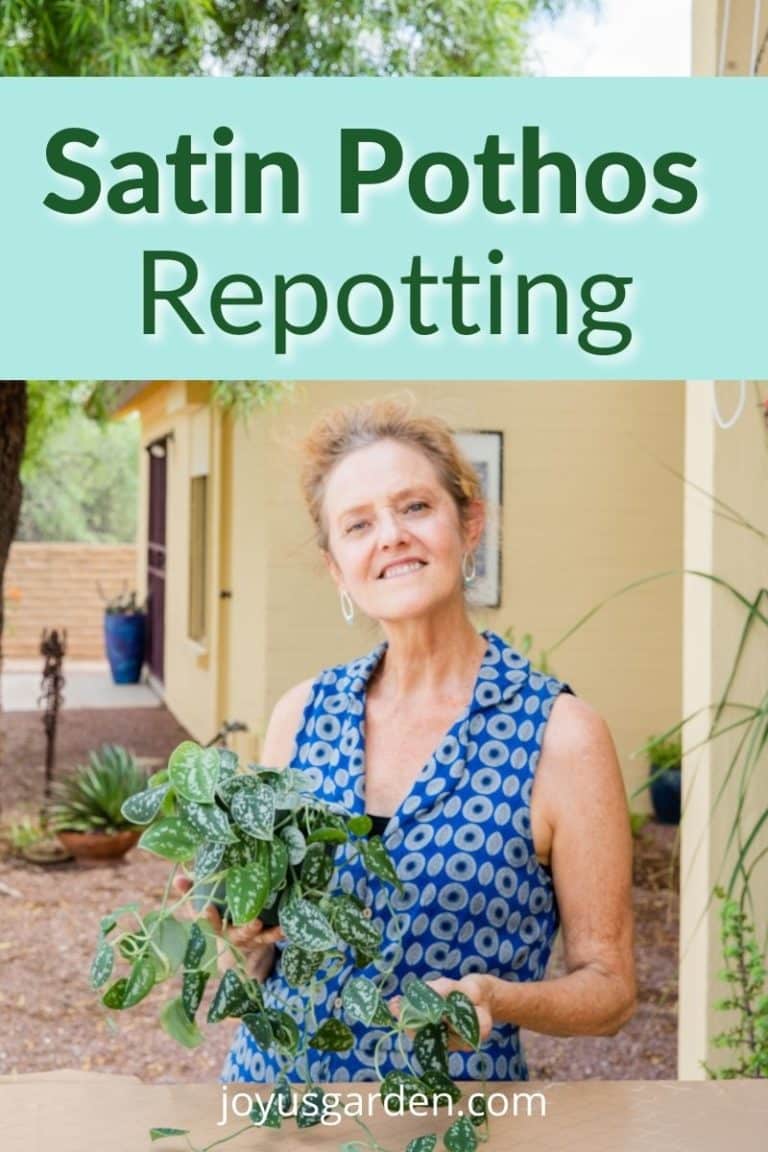


I do read your garden info, especially when I have similar plants. I live in Scottsdale, so my plant needs are close to your Tucson environment. I actually split my huge zz plant a few years ago with the help of your on-line instructions. All three of my plants are doing well!
Hi Diana – I was just up in Scottsdale a few days ago. My plants are doing well here too despite the lack of humidity. Air plants take more work though. I love the ZZ Plant – so glossy & easy to care for! Nell
I am so happy to have stumbled on you. It helps to find someone who deals with the summer AZ heat as well. I bought a Imperial Red at a local Tucson shop back in May. It had a new leaf that hadn’t opened yet. This leaf still hasn’t opened The sheath has now fallen off, but the leaf is still closed. Is this normal? I’m in Phx, and have it in a north facing window.
Hi Prudence – The new growth on mine (which is still a small 6″ plant) is slow to open too. My other Philodendrons put out new growth faster. Nell